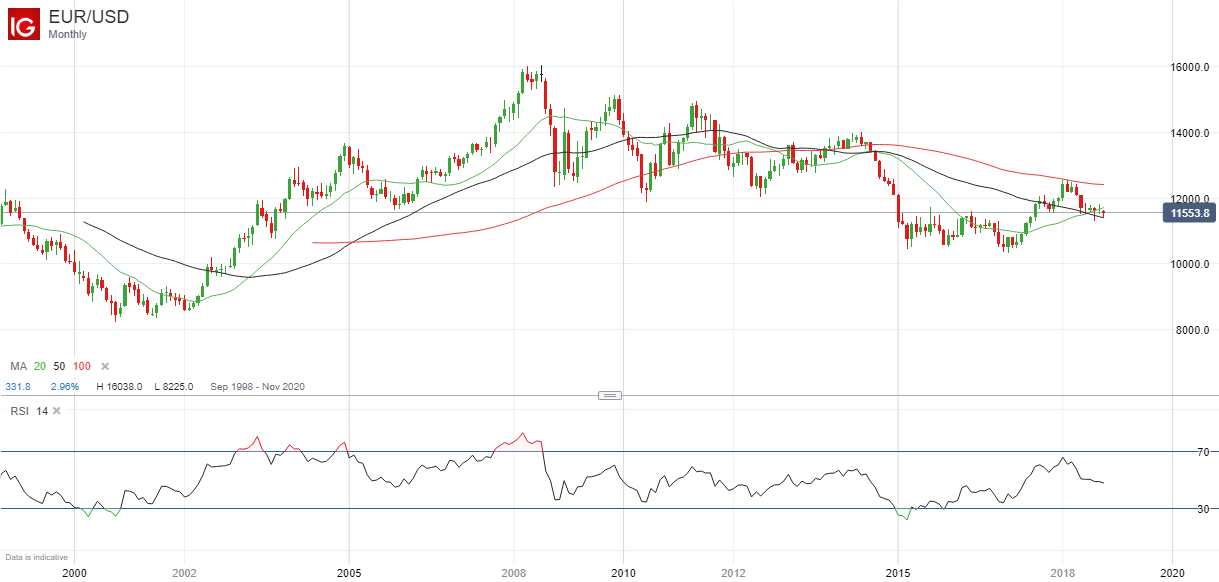Euro Analysis: The Potential Impact Of Brexit And The Italian Budget Clash
IS EURO STABILITY UNDER THREAT?
As the UK and the European Union argue over Brexit, and Brussels clashes with Rome over the Italian budget, the future stability of the EU and the Euro is again in the spotlight. While the possibility of lasting damage to the single currency will likely be a concern for long-term investors rather than short-term traders, even day traders would be wise not to ignore them.
At the heart of the argument, from day one, has been criticism that monetary union will not work without fiscal union, political union and a lender of last resort. As it is, interest rates and monetary policy in general are decided by the European Central Bank. However, fiscal policies – on tax, spending and borrowing – are not decided on centrally but by individual EU governments.
CRITICISM OF THE EU AND THE EURO
Predictably, this has been highlighted by left-leaning economists such as Columbia University Professor Joseph Stiglitz, who has written a book entitled The Euro: How a Common Currency Threatens the Future of Europe. Less predictably, even the former European Commission President Jacques Delors, an architect of the single currency, reportedly told London’s The Daily Telegraph newspaper in 2011 that the Euro project was doomed from the start and that the current generation of European leaders had failed to address its fundamental problems.
However, there has been little evidence of this so far in the EURUSD exchange rate since the currency was introduced in January 1999, and even the Eurozone debt crisis of 2009-2012 had only a limited impact on the exchange rate.
EURUSD PRICE CHART, MONTHLY TIMEFRAME (JANUARY 1999 – OCTOBER 2018)
(Click on image to enlarge)

These are some of the principal concerns about the EU and the Euro – both political and economic – that have been expressed:
- Continuing inequality between richer countries like Germany and poorer countries such as Romania and Bulgaria – leading to talk of a “two-speed” Europe.
- A lack of economic reforms, resulting in relatively subdued economic growth and relatively high unemployment.
- Too many restrictions and rules, with a lack of public accountability, reduced national sovereignty and undemocratic institutions.
We do not comment on politics but the Brexit referendum in the UK in June 2016 suggested a widespread mistrust of the EU while the general election in Italy in March 2018 pointed towards support for liberal values ebbing, as it is elsewhere.
For traders, the key chart to watch is the spread, or difference, between the yields on Italian government bonds (BTPs) and German government bonds (Bunds), which tends to rise when tensions increase and fall when they decrease.
ITALY/GERMANY 10-YEAR YIELD SPREAD, DAILY TIMEFRAME (JANUARY 1 – OCTOBER 17, 2018)
(Click on image to enlarge)

Source: Thomson-Reuters Eikon
As the chart above shows, the yield spread has climbed strongly this year as disquiet over the Italian election result and the budget dispute has risen. If this continues, the Euro will likely weaken. A failure to agree on the terms of Brexit, which has so far affected the British Pound rather than the Euro, could well damage the single currency too.
Disclosure: Do you want to see how retail traders are currently trading the US Dollar? Check out our IG Client Sentiment ...
more


